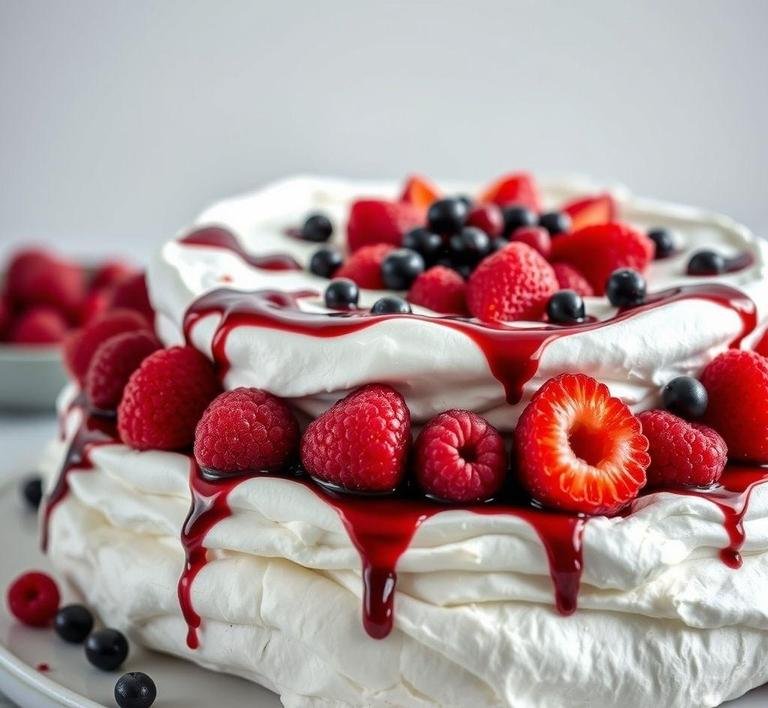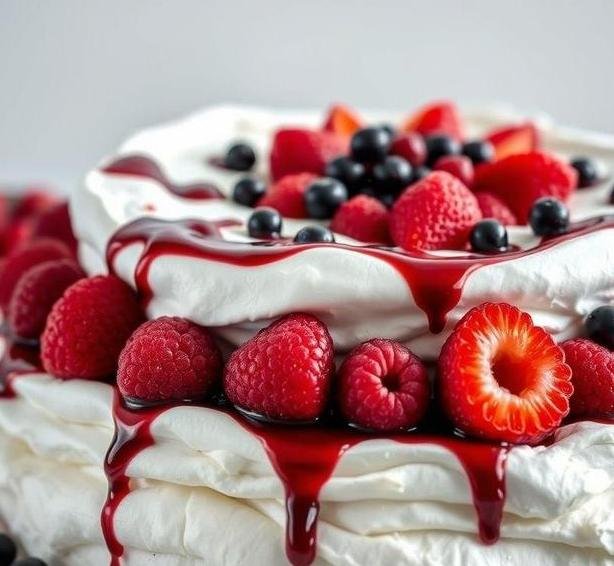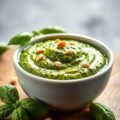Mary Berry, the beloved doyenne of British baking, brings a timeless elegance to every dish she touches-and her pavlova is no exception. This dessert is a meringue-based confection with a crisp crust and a soft, marshmallow-like interior. What makes this version special is the vibrant topping of ‘rosy red fruits’-think strawberries, raspberries, and redcurrants-glistening with a syrup made from cassis, a blackcurrant liqueur.
The pavlova itself is a dreamy cloud of baked meringue, whipped into stiff peaks and baked low and slow to maintain that signature crunch on the outside and chewiness on the inside. The fruit topping offers a tart contrast to the sweet meringue, while the cassis gives a grown-up, aromatic depth that elevates this dessert from simply sweet to stunningly sophisticated.
Whether served at a summer garden party or as the grand finale to a dinner with friends, this pavlova is as delightful to look at as it is to eat.
Mary Berry’s Pavlova With Rosy Red Fruits And Cassis Recipe
Ingredients Needed

Here’s a detailed breakdown of everything you’ll need for this luscious dessert. These ingredients are quite accessible, yet together they create something truly magical.
For The Meringue Base
- 4 large egg whites, at room temperature
- 225g (1 cup + 2 tbsp) caster sugar (superfine sugar works best for meringue)
- 1 tsp white wine vinegar
- 1 tsp cornflour (cornstarch)
- Few drops of vanilla extract
For The Cream Topping
- 300ml (1¼ cups) double cream (heavy cream)
- 1 tbsp icing sugar (optional, for sweetening the cream)
- ½ tsp vanilla extract
For The Rosy Red Fruit Topping
- 200g (7 oz) strawberries, hulled and halved
- 150g (5 oz) raspberries
- 100g (3½ oz) redcurrants, stemmed
- 3 tbsp crème de cassis (blackcurrant liqueur)
- 1-2 tbsp icing sugar, to sweeten the fruit, depending on taste
Note: You can adjust the fruits depending on the season or your personal preference-cherries, pomegranate seeds, or even sliced plums could work beautifully here too.
Equipment Needed
Good tools make good cooking a whole lot easier. Here’s what you’ll need to get started:
- Electric mixer (stand mixer or hand-held)
- Mixing bowls (non-plastic, as grease can hinder meringue formation)
- Rubber spatula
- Baking sheet/tray
- Baking parchment or silicone baking mat
- Sieve (for dusting icing sugar)
- Cooling rack
- Serving plate or cake stand (because presentation counts!)
Instructions To Make Mary Berry’s Pavlova With Rosy Red Fruits And Cassis
This is where the magic happens. The process is a meditative dance of whipping, folding, baking, and assembling. Let’s walk through it step-by-step.
Step 1: Preheat And Prepare
- Preheat your oven to 150°C (130°C fan)/300°F/Gas 2.
- Line a baking tray with parchment and draw a circle (about 20cm/8-inch diameter) as a guide.
Step 2: Make The Meringue
- In a clean, grease-free bowl, start whisking the egg whites on low speed until frothy, then increase to high speed until soft peaks form.
- Add the caster sugar a spoonful at a time, whisking between additions. Continue beating until the meringue is stiff, glossy, and the sugar has dissolved (rub a bit between your fingers-there should be no grittiness).
- Gently fold in the vinegar, cornflour, and vanilla extract.
Step 3: Shape The Meringue
- Spoon the meringue onto your prepared parchment, staying within the drawn circle. Use a spatula to shape it into a nest-thicker on the sides and slightly hollow in the center to hold the cream and fruit later.
Step 4: Bake The Meringue
- Place in the preheated oven, then immediately reduce the temperature to 140°C (120°C fan)/275°F/Gas 1.
- Bake for about 1 hour, then turn off the oven and leave the meringue inside to cool completely, ideally with the oven door slightly ajar. This gradual cooling prevents cracking.
Step 5: Prepare The Fruit Topping
- While the meringue cools, toss the berries in a bowl with the cassis and icing sugar. Let them macerate (marinate) for 30-60 minutes so they release their juices and absorb the liqueur’s deep flavor.
Step 6: Whip The Cream
- In a chilled bowl, whip the cream with the vanilla and optional icing sugar until soft peaks form. Don’t overwhip-you want it soft and cloud-like.
Step 7: Assemble The Pavlova
- Place the cooled meringue base on a serving plate.
- Spoon the whipped cream into the center.
- Top generously with the macerated fruit and drizzle over any syrupy cassis juices for extra gloss and flavor.
Tips And Tricks
Here’s where we go beyond the recipe into Mary Berry-level mastery.
- Room temperature eggs whip better. Cold egg whites take longer and won’t reach the same volume.
- Use superfine sugar-it dissolves faster and more completely than granulated, ensuring a smooth, glossy meringue.
- Clean bowl is critical. Any trace of fat will ruin your meringue. A wipe with a cut lemon before starting can help.
- Don’t rush the cooling process. The meringue needs to cool in the oven to prevent cracks and to keep that marshmallowy interior intact.
- Avoid making it on a humid day. Meringue is hygroscopic-it soaks up moisture and can become chewy or weepy.
- Make ahead friendly! You can make the meringue base a day or two in advance and store it in an airtight container. Assemble just before serving for best texture.
Mary Berry’s Pavlova with Rosy Red Fruits and Cassis isn’t just a dessert-it’s an experience. It’s a joyful balance of textures and flavors: crisp and creamy, sweet and tart, light yet indulgent. It speaks of summer picnics, garden teas, and elegant dinner parties, all with that unmistakable Berry signature: effortless beauty and timeless taste.
Whether you’re baking it for a special occasion or just because you deserve a little luxury, this pavlova invites admiration. It’s proof that with a few simple ingredients-and a bit of care-you can create something truly extraordinary.
So go on, put the kettle on, cue up a bit of classical music, and get whisking. Mary would be proud.
Easy Recipe Variations For Mary Berry’s Pavlova With Rosy Red Fruits And Cassis

Mary Berry’s original pavlova recipe is the very definition of a refined British classic-pillowy meringue with a crisp shell, lush cream topping, and a jewel-like cascade of red fruits enriched with the tangy depth of blackcurrant liqueur (cassis). But one of the best things about pavlova is how adaptable it is. Once you’ve mastered the base, you can have a bit of fun with it.
1. Tropical Twist:
Replace the red fruits with sliced mango, passion fruit pulp, and pineapple for a vibrant tropical version. Swap cassis for a drizzle of passion fruit syrup or a splash of Malibu for a hint of coconut. The tropical acidity plays beautifully with the sweet meringue and rich cream.
2. Berry & Basil Fusion:
Add a fresh herbal note by mixing torn basil leaves into the macerated red fruits. The unexpected flavor of basil complements strawberries and raspberries especially well. You can even steep the cassis with a sprig of basil for a few minutes to infuse a subtle green note.
3. Chocolate-Lovers’ Delight:
Fold a handful of finely grated dark chocolate or cocoa nibs into the meringue before baking for a touch of bitterness and texture. Then top your pavlova with cherries, a splash of kirsch instead of cassis, and whipped cream laced with a little cocoa powder. It’s indulgent, rich, and dramatic.
4. Vegan Pavlova:
Aquafaba (the liquid from a can of chickpeas) makes a fantastic egg white substitute. Whip it with cream of tartar and sugar until glossy peaks form. For the cream layer, go for whipped coconut cream, and drizzle with a reduction of cassis and red berries simmered lightly on the stove.
5. Mini Pavlovas:
Make individual meringue nests for single-serving desserts. These are perfect for parties or afternoon teas, and they look utterly adorable. Plus, guests can customize their toppings-fruit-only for the purists, cream-heavy for the indulgent, or boozy for the adventurous.
Storing Leftovers
Pavlova doesn’t like to sit around for too long-moisture is its natural enemy, and a soggy meringue is no one’s idea of a treat. But if you do find yourself with leftovers, there are a few ways to keep them as fresh as possible.
1. Separate Before Storing:
If you know in advance that you’ll have leftovers, try to store the meringue base and the toppings separately. The meringue can be kept in an airtight container at room temperature for up to two days. Humidity is the enemy here-so keep it cool and dry.
2. Assembled Leftovers:
If the pavlova has already been fully assembled, pop the leftovers in the fridge in a loosely covered container. Don’t seal it completely airtight-you want to avoid condensation, which can accelerate sogginess. Try to eat it within 24 hours for the best texture, though the flavor will still be lovely even if the meringue softens a bit.
3. Refreshing the Meringue:
If your leftover meringue has gone soft, you can try a little trick: place it in a low oven (about 110°C/230°F) for 10-15 minutes to help it crisp up again slightly. Keep a close eye on it, though-you don’t want it to brown or crack.
What To Eat With Mary Berry’s Pavlova With Rosy Red Fruits And Cassis?
Pavlova is a star in its own right, but pairing it with the right drinks or side bites can elevate it into an unforgettable experience. Here are some delectable suggestions:
1. Wine Pairings:
A glass of rosé Champagne or a late harvest Riesling complements the red fruits and cassis perfectly. For something more indulgent, try a Moscato d’Asti-light, bubbly, and sweet enough to balance the dessert without overpowering it.
2. Tea or Coffee:
A fragrant Earl Grey tea with its hints of bergamot is a beautiful, subtle partner. For coffee lovers, a smooth cold brew or aeropress espresso with mild acidity can contrast the sweetness and offer a balanced bite.
3. Cheese Board Companion:
If you’re serving pavlova as part of a larger spread, a light cheese board with soft cheeses like goat’s cheese or brie, fresh figs, and almonds makes an elegant companion. It contrasts the sweetness with creamy, savory notes.
4. Extra Garnishes:
Serve your pavlova with a scoop of lemon sorbet or vanilla bean gelato on the side for an extra cool finish. You could also drizzle a little balsamic glaze over the fruits for a modern gourmet twist-it intensifies the berry flavors in an unexpectedly delightful way.
Conclusion
Mary Berry’s Pavlova with Rosy Red Fruits and Cassis is more than just a dessert-it’s a centerpiece, a celebration, and a sensory experience. The crisp meringue shell gives way to clouds of whipped cream and vibrant, macerated fruits, with the cassis lending a seductive depth of flavor. But what truly makes this dessert shine is its versatility. Whether you’re adapting it for seasonal fruits, turning it into vegan magic, or dressing it up for an elegant dinner party, pavlova rises to the occasion.
And while leftovers might not be quite as perfect the next day, a little care in storage can keep the magic alive. Pair it thoughtfully, serve it with flair, and you’ve got a dessert that’s bound to be remembered. Pavlova may have originated in the Southern Hemisphere, but in Mary Berry’s hands, it’s the crowning jewel of British dessert tables everywhere.
FAQs
What Makes Mary Berry’s Pavlova With Rosy Red Fruits And Cassis Unique?
Mary Berry’s Pavlova with Rosy Red Fruits and Cassis stands out because of its delicate balance of textures and flavors. The crisp, airy meringue shell is complemented by a smooth and tangy whipped cream topping, adorned with fresh, vibrant berries like raspberries, strawberries, and currants. The addition of cassis (a blackcurrant liqueur) adds a rich, slightly tart sweetness that elevates the dessert, making it a sophisticated twist on a classic pavlova.
Can I Substitute Cassis In Mary Berry’s Pavlova Recipe?
Yes, if you can’t find cassis or prefer a non-alcoholic version, you can substitute it with a combination of blackcurrant syrup or fruit puree. For a similar flavor profile, try using raspberry or cherry liqueur, though the overall taste will slightly differ. If you want to keep it alcohol-free, a splash of fruit juice like blackcurrant or raspberry juice mixed with a bit of sugar can mimic the tartness and sweetness of cassis.
How Can I Make The Pavlova Meringue Crispy But Not Overly Dry?
To achieve a perfectly crispy meringue that isn’t too dry in Mary Berry’s pavlova, it’s important to carefully follow the baking process. First, ensure the egg whites are whisked to stiff peaks and the sugar is added gradually. Bake the pavlova at a low temperature (around 120°C or 250°F) for a long time-usually about 1.5 to 2 hours-until it has a light golden color. Let the pavlova cool in the oven with the door ajar to prevent cracking. This gentle approach ensures a crunchy exterior while keeping the center soft and marshmallow-like.


